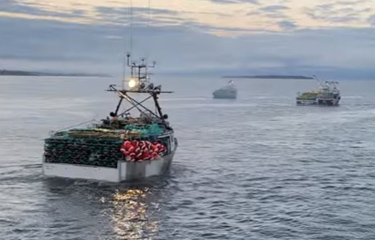Canada’s lobster season underway amid continued controversy and CAD 10 per pound price

Canada lobster fishing areas (LFAs) 33 and 34 are officially open for the season, with solid prices helping harvesters brave chilly December conditions.
Fishermen in LFA 33 set their gear on Sunday, 26 November, and hauled traps in the following day, receiving CAD 10.00 (USD 7.37, EUR 6.82) per pound from dealers. Neighboring LFA 34, the largest fishery in Canada, opened on 2 December after LFA 34 port representatives delayed the start five days due to poor weather – an event not unheard of in the fishery, as it was also delayed in 2022. That fishery is receiving similar dockside prices.
However, the fishery continues to be riven by controversy surrounding Indigenous harvesters' claims they should be allowed to go lobstering out of season under treaties granting them the rights to earn a moderate livelihood from fishing.
Multiple First Nations in Atlantic Canada have access to Treaty Right Protected (TRP) lobster harvests, granting certain off-season fishing rights and the right to fish lobster “in pursuit of a moderate livelihood” during the established seasons in LFA 33, 34, and 35. The Canadian Department of Fisheries and Oceans (DFO) reached an agreeement in 2021 with First Nations allowing the setting of up to 3,500 lobster traps – at 70 per harvester – in the fall season in the LFAs.
According to a release from the Mi’Kmaw communities in the traditional district of Kespukwitk, which includes the Wasoqopa’q, Annapolis Valley, Bear River, and Glooscap First Nations, the Kespukwitk TRP Species-Specific Lobster Plan they shared on 12 October, 2023 had authorized 7,500 traps, with 75 harvesters fishing 100 traps each.
The DFO, however, imposed a trap limit of 5,250 traps in a late response, despite the Mi’Kmaw informing the department the number of traps allocated in previous years was inadequate.
“This news is frustrating for the communities, as we have made several attempts to demonstrate the insufficiency of the current trap allocation, particularly within the commercial lobster season,” Assembly of Nova Scotia Mi’kmaw Chiefs Fisheries Co-Lead and Annapolis Valley First Nation Chief Gerald Toney said in a release.
As First Nations push for more trap allocations, commercial harvesting groups have heavily criticized the DFO for a recent interim authorization they said allowed moderate livelihood traps to be fished by non-Indigenous harvesters who lease commercial licenses held by First Nations, the CBC reported.
"It's a clear breach of good faith between the fishing communities of southwest Nova Scotia and the federal government,” Bay of Fundy Fishermen’s Association Spokesperson Colin Sproul told the CBC.
The Assembly of Nova Scotia Mi’kmaw Chiefs disputed the claim, saying in a community notice the associations are perpetuating misinformation, “increasing violence and tensions for our harvesters on the water.” The associations, meanwhile, said the situation is a failure of government and called for the DFO to be transparent on regulation of treaty rights.
Tensions previously flared between commercial harvesters and First Nations groups in 2020, following reports of commercial fishers removing Indigenous lobster traps. Several fishermen were arrested on assault charges after confrontations between First Nations harvesters and commercial harvesters.
As tensions flare between groups, the fishery as a whole also has to grapple with potentially increased scrutiny stemming from a ...
Photo courtesy of the Coldwater Lobster Association





Share